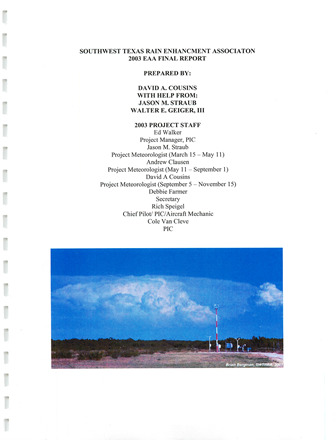Southwest Texas Rain Enhancement Association 2003 EAA Final Report

| Author | Cousins DA, Staub JM and Geiger WE III (Southwest Texas Rain Enhancement Association) |
| Year | 2003 |
| Description | Report of the Edwards Aquifer Authority weather modification program for 2003 in Uvalde County |
| Publisher | Southwest Texas Rain Enhancement Association |
| Location | Uvalde County |
| Cover | View Download |
| File | View Download |
| Summary |
|
The Southwest Texas Rain Enhancement Association has just now completed its fifth year of operations and the third full year of 24-hour 7-day per week cloud seeding. This was a very active year weather wise. There were 100 flights during this year’s 8-month season. Of the 100 flights, 28 (20 during the contracted season with the Edwards Aquifer Authority) took place over Uvalde County. The SWTREA continued to serve as a demonstration program to many of the other weather modification programs in Texas demonstrating effective rain enhancement and hail suppression techniques on many different types of storms at any time of the day or night. As per table 7 on page 30, one can see that the 2003 was more active in terms of the number of flights taking place over Uvalde County than the 2003 season. Again the total number of flights in 2003 were [sic] 20 as compared to 17 in 2002. One can [sic] Also when you compare the 2003 total season rainfall for May through October with the same total for the 30 year average precipitation one will find that the rainfall for 2003 was slightly above normal for Uvalde County. One can also [sic] This is supported by the Ruiz Assessment in Appendix A, which shows that an additional 36.733-acre feet of rainfall was created for Uvalde County from cloud seeding activities. Further more [sic], by looking at the Ruiz Assessment in Appendix A, one can see that the SWTREA aircraft were on time for 87% of the small clouds and 100% on time for large clouds, which formed inside the target area. Timing for type B clouds, clouds that formed outside the target area and are at least 1-hour old, was 48%. The reader may ask why is there such a large on time difference in timing for clouds that form inside the target area and Type B clouds. This is due to the fact that the project must wait for the cloud to enter the operational area to be legally seeded. Therefore one can quickly see that the proper procedure for delivering the agent in the first half-life of the cloud is often not possible. The reader can then infer that the poor timing on type B clouds is often beyond our control. |
Search for Documents
Advance Search
Explore EAA's Scientific Reports
- All Reports
- Surface Water / Groundwater Relationship
- Biology
- Springs, Groundwater Discharge
- Archaeology
- RZ Protection
- Aquifer Levels
- Remote Sensing
- Precipitation
- Overview Studies
- Modeling
- Hydrology and Hydrogeology
- History
- Groundwater Recharge, Recharge Zone
- Groundwater Movement
- Geomorphology and Caves
- Weather Modification
- Geology
- Water Use and Conservation
- Geochemistry
- Water Resources Planning and Management
- Floods and Drought
- Water Quality
- Climatology
